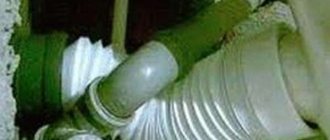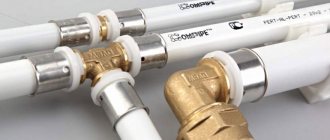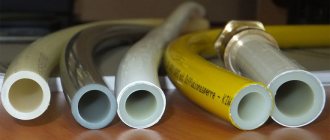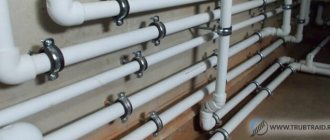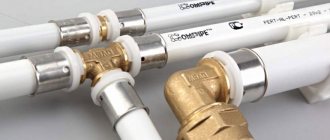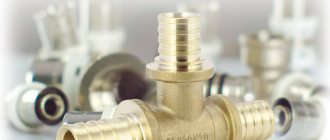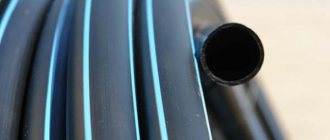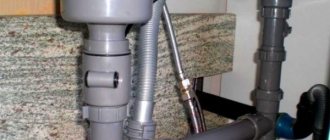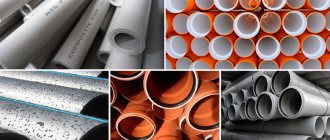Technologies are constantly evolving, affecting almost all areas of human life. This also happened with pipeline systems that organize water supply, sewerage, heating and drainage. Some time ago, products made of metals and alloys were installed everywhere. Nowadays, products made from PVC and HDPE are in greater demand on the market; they are superior in many respects. In the article we will look at the features of PVC and HDPE pipes and what is the difference between them.
PVC product for internal sewerage
Material of manufacture
Low-density polyethylene is used to produce HDPE products. In turn, the differences here are in the manufacturing method: non-pressure (low pressure) and pressure (medium pressure). A separate class is worth highlighting high-pressure products - LDPE.
Low-pressure polyethylene
PVC products are made from polyvinyl chloride, without carcinogenic impurities in the composition. Children's toys are made from this material. Its distinctive feature is that it is recyclable.
General description
PVC: gray plastic pipes familiar to residents of the country. Made by melting polyvinyl chloride. Available with the following parameters:
- Pressure - 6-16 bar;
- Diameter - 9-50 cm;
- Length - up to 6 m.
The service life of such products is on average 60 years. The manufacturing technology was developed in the 30s;
HDPE: black or blue polyethylene pipes. They have the following characteristics:
- Pressure - 4-20 bar;
- Diameter - 1.6-160 cm;
- Length - up to 12 m, 13 meters for gas ones.
The service life is the same as the previous option. The technology is newer - it originated in the 60s.
What is the difference between PVC and HDPE pipes
HDPE products are suitable for almost any environment, while PVC can only transport liquids. Pipelines assembled from these materials can deliver various active substances: salt, acid, alkali, and so on. Both types of products can withstand significant temperatures - no more than +60 degrees Celsius. But only HDPE pipes can withstand frost. If you use PVC products in cold weather (from -10 degrees), they can simply crack and fragments of material will invariably get into the liquid transported through them.
As for the strength characteristics, they are almost the same for both options. HDPE will withstand especially impressive loads.
The socket method is used to connect PVC products. To install such a pipeline, electrofusion welding or the butt welding method is used.
Polyethylene is an inert type of coating, so it perfectly resists environmental influences. When working with the material, no special precautions are required, as it is absolutely harmless to humans.
PVC, in turn, after a certain period of operation begins to release toxic substances, namely complex chlorides. It is for this reason that such products are not used in all areas of human life. Because of this factor, product disposal becomes more complicated, requiring additional costs. If it is necessary to use pipes for the drinking system, then a special subtype of product is now produced - uPVC products, which are non-plasticized polyvinyl chloride. It will not release harmful substances into the air and pipeline.
The modern market offers a large selection of pipes
Why do you need to determine the type of plastic yourself?
For example, polyethylene practically cannot be glued; it can only be welded. All types of polyethylene soften in boiling water.
Polycarbonate successfully withstands negative temperatures, and polystyrene quickly cracks.
Dichloroethane dissolves polystyrene and plexiglass well, and is used for gluing them together as the best glue.
To repair the interior cabinet of polystyrene refrigerators when it cracks, they use dichloroethane-based glue (it’s called “Dichloroethane. Glue for plastic”) and even the universal Chinese superglue “Second”. They carefully coat the cracks. But you need to work with this volatile substance very carefully, as it is toxic! And when dried, it is safe after binding with polymer molecules. This glue is widely used in refrigerator factories for minor repairs in manufactured refrigeration appliances.
There is often a need to identify the type of plastic when sorting before recycling to ensure that all sorted plastic is homogeneous. It is for recycling that plastic designations exist.
Curious consumers and those who care about their health are also interested in the question of what type of plastic food is packaged in. After all, there are types of polymers, for example, melamine and polyurethane, the use of which in contact with products is prohibited. By the way, this is why melamine and polyurethane are not on the list of markings.
Where are PVC pipes used?
*
Using these products:
- Water supply systems are installed;
- Irrigation systems are being created;
- Free-flow sewerage is being laid;
- Storm drains are being installed.
PVC products come in two types: chlorinated and made from non-plasticized polyvinyl chloride.
The main advantage of the first type is the high melting point (more than +480 degrees Celsius). And thanks to the high mechanical strength, high-pressure pipelines are created from these products. Excellent resistance to aggressive media makes it possible to pump strong acids and other reagents through such systems. CPVC pipes are used when it is necessary to transport water, vegetable oil, juice or any other liquid food product.
uPVC products
Pipes made of non-plasticized plastic cope well with operating temperatures from 0 to +60 degrees Celsius, therefore they are suitable for transporting alkalis, acids and other aggressive liquids. They are safe for humans, so they also supply water.
HDPE or PVC pipe: which is better?
It is not entirely correct to pose the question of which is better – HDPE or PVC pipes, since they have different scopes of application. HDPE products are intended for external pipelines. PVC pipes are for other situations. Moreover, polymer pipes are presented on the market in a wide range with various performance characteristics, guaranteeing consumers the optimal choice in any situation.
Here we should talk more about the correct choice of pipes so that they meet the assigned tasks. The main selection criteria include:
- purpose of the pipeline;
- throughput;
- method of laying pipes - above ground, underground, in trenches or trays;
- type of pipe connection;
- designed characteristics of the future pipeline - operating pressure, operating and ambient temperature, etc.
Selection errors can cause accidents due to insufficient operational parameters of the selected pipes or lead to overpayments for clearly excessive product characteristics.
For example, a significant part of the range of pipe sizes for pressure and non-pressure pipelines is completely the same, but this does not mean that they are interchangeable. More precisely, pressure pipes can replace products for non-pressure networks, but it will cost you much more. The reverse situation is unacceptable in principle.
A common mistake is choosing the same pipes for heating and hot water supply systems. If in the first case you need products designed for operating temperatures up to 95 °C, then for hot water systems, pipes for water with temperatures up to 60 °C are sufficient. By the way, HDPE and PVC pipes contain a safety margin in case of emergency situations. They must withstand exceeding the rated operating temperature by 20 °C for 100 hours while maintaining the tightness of the pipeline.
Areas of application of HDPE products
Pipes made of low-density polyethylene are widely used in sewerage systems, water supply systems and wells.
Such products are most relevant when organizing a sewer system. This is due to their advantages:
- High strength index;
- They do not allow sounds to pass through (when sewerage is running, this is an important plus);
- They are able to bend at any angle - this is the main difference between HDPE and PVC.
Note! In appearance, such pipes differ from PVC products in that their walls are thicker and more flexible.
HDPE is used to make containers for septic tanks, wells and other similar structures that will be exposed to aggressive environments for a long time.
If a sufficiently strong product is used, it is suitable for the role of a casing pipe, which is not afraid of soil movements. The most that will happen to it is a slight deformation. Their assembly is very simple: end-to-end or using threads.
Summary
We found out the difference between PVC and HDPE pipes. Polyethylene products can withstand large and narrowly targeted loads and withstand frost better. They can be used for pumping gas and laying wires. There are no other differences between the products.
The integrity of the manufacturer plays an important role in quality. Example: in workshops, PVC channels are melted from powder, which is pre-mixed with the necessary ingredients. If the proportions are deviated from the norm, the product becomes fragile, sometimes turning yellow after 3 days. With us you will not encounter such a problem.
Connection of PVC and HDPE pipes
*
Dissimilar materials can be fixed in several ways:
- Threaded fittings - fixation is carried out at the end of the pipe using the welding method. For this purpose, the fitting is disassembled, one part of it is welded to the end of one pipe, and the threaded section is welded to the other. To melt plastic, you will need to use a special apparatus that will make the connection strong and airtight. If this is an integral section, then it is important to use a fitting with an embedded heating element;
- Collet coupling - this design is dismountable and is assembled from a collet, a clamping nut and a thread. At the moment there is a wide range of couplings for plastic pipes. To connect two types of products, the coupling is first disassembled, after which the collet is inserted into one of the pipes and secured with a clamping nut. Next, the structure is tightened. The fitting should not be overtightened, which could lead to deformation of the edges of the product. The final stage is connecting a pipe of another type to the thread;
- Flanges - the method is relevant for large diameter risers, sewers and other elements. In addition to the flange, a sleeve is additionally used to fix it. The connection method itself is similar to using a collet coupling - the structure is disassembled and fixed on different pipes to already installed bushings. Fix the area with union nuts;
- Cold welding. The work requires a special soldering machine. The adhesive mass is a special mass of minerals and polymer compounds. It is characterized by high-quality adhesion and provides a reliable, tight connection. The method is relevant for those areas where water is transported by gravity.
Additional elements are used for connection.
To make the connection of two products more dense, a wide variety of materials are suitable. For threaded fittings and collet couplings, fum tape is relevant, and for flanges, gaskets made of rubber or asbestos are used.
Approximate prices, pros and cons
Among the advantages related to both types of corrugation are:
- Durability: the service life of corrugated electrical wiring is at least 50 years, and in optimal conditions – much longer;
- Protection of wiring from overheating, cables sticking together, abrasion;
- No need to think about grounding;
- Insulation from moisture;
- A steel broach inside the corrugation helps speed up installation;
- Due to corrugation, you can abandon expensive cables and use more affordable ones.
PVC corrugated material is valued for its excellent insulating properties. Its use helps to avoid the induction of stray currents, which makes it possible to lay several cables with different technical parameters inside one pipe at once.
The table below shows prices for HDPE corrugated pipes (for external work).
What are the differences, and which corrugated pipes are better?
PVC corrugation is produced predominantly in gray color, so it is easy to distinguish it from others both in the lining and in the store window. It has the valuable property of self-extinguishing, which is very important when installing particularly critical networks with increased fire safety requirements. The moisture resistance of this type of corrugation is not too high, inferior to analogues from other materials. Preferred scope of application: residential and industrial premises with a normal level of air humidity (50-60%).
Polyethylene pipes come in different colors: orange, black. Polyethylene itself is flammable and, in comparison with PVC, is not resistant to water and aggressive chemical influences. It is this type of corrugation that is chosen for the installation of electrical networks in concrete screeds, grooves inside plaster and other non-combustible materials, for laying open wiring outdoors, that is, for the street.
The differences between the two varieties are quite serious, so they cannot be said to be 100% interchangeable.
